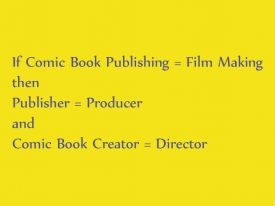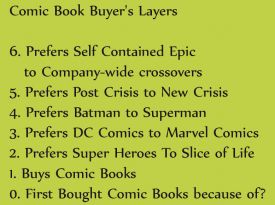Comics /
Spotlight
Why Do Comic Book Readers Exist?
By Hervé St-Louis
February 17, 2008 - 15:01
The main challenge of self publishers in the comic book industry is to understand that the art component is but a piece of the action. Currently, the perspective most self publishers, and even established ones have is a focus on products alone and not marketing. These publishers and creators believe that all that is required to sell a comic book is a product.
Following the previous article I wrote about the lack of business leadership in the comic book industry a few weeks ago, I mentioned that a good publisher should care as much about the readers he serves as the creator he publishes – and in many cases about the work this creator self publishes. This is an alien thought to many comic book professionals.
Sequential Art Expression through Art
The main problem facing budding and professional comic book creators is that although they can practice their art, if they are to have a viewing audience, some kind of economic action will be involved. Comic book creators are like filmmakers. Often, teams are required to complete a project. This involves some kind of capital investment in time, money, technical and human resources.
For the visionary or director of the project this involves worrying about paying for the work done to complete the project. In film, filmmakers have producers who worry about financing a project and making sure it is viable commercially. In comic books, there is a notion that producers, otherwise known as publishers are not necessary and that a “director” can also function as a producer.
Because publishing is not as complex a task as film making, and especially in these times, access to the technology and expertise is enhanced, there is an ongoing myth that a comic book director can also become a comic book producer. The problem is that traditionally, producers are hardly worried about the process of printing a film to a celluloid master. They are usually more worried about making any endeavour a viable risk.
In other words, the availability, in North America of a restricted but well defined distribution channel for comic books and the relative ease of publishing makes the process seem easy and accessible to laymen. Most creators think they can fulfill the basic tasks required to make the product and even distribute it where most readers will see it.
But process has nothing to do with business. Having a product does not mean a sale will occur or even that a comic book will find an audience. If creators want to spend their time learning about publishing, then they should, but they should not confuse publishing with generating a viable commercial project. Even those publishers who think that they can skip some steps by putting their products online are confusing the creation of a product with the marketing of a product.
Once a comic book is published in print or distributed electronically, the work of the publisher does not stop. In fact, it has only begun. Those creators, who are content with actualizing a goal by creating a comic book unit, should be happy and just stop there. I suspect for most creators, that this is sufficient. But usually, there is something in the back on the mind of the creator that says, “Hum, maybe I should try to get people to buy this $10,000 comic book. “ This is when creators will send review copies and press releases and buy a few ads hoping that will be enough to generate a few sales. They hope that word of mouth will do the rest and that eventually they can retire to Cuba at the age of 55. “I mean, the product is good. It’s groundbreaking. Of course it will sell.” That thousands have had the same dream and failed before is of no consequence. “I am special, and I will make it.”
This common attitude ignores an important fact. Who are the people who will be buying this comic book or even viewing it online? Why should they even pay for it?
Even established publishers don’t seem to have a clue about who their comic books are intended to. There is no market research. No survey sent. No means of understanding what motivates a customer to buy a comic book. The whole comic book making process is removed from the calculations of real lives. The thought that maybe a teenage kid somewhere in Oklahoma has only so much allowance money to buy one comic book a week worth no more than four dollars is lost to the minds of most comic book publishers and the majority of self publishers.
Officially they pay lip service to the reader, but this being is like a black hole to them. It is an unknown and a void that they do not understand. If at best they try to understand them, they will draw from their own experience and other anecdotal references instead of empirical data.
What’s Your Origin?
In order to understand why a comic book reader buys a book, some publishers have begun promoting comic book creators. Their logic is mostly sound. They believe that if Creator A is popular, that if he participates in the development of Comic Book B, his endorsement and participation will make the product more interesting to an audience. The same fuzzy logic is also used with popular characters like
Batman or
Spider-man. If Batman can sell so many books per month, adding him to another book will, in theory increase its sales.
While part of this logic has some validity, this circumvents the real question of why people buy comic books in the first place. Before buying every apparition of Spider-man in a comic book, or anything drawn by Jim Lee, this comic book buyer has to come from somewhere. To use familiar terms, he needs an origin. The origin part is where most publishers fail to understand the customer. Where do comic book readers come from and why do they stick? Why don’t they stick, why do some come by and leave as fast? Why do some start in old age and become hardcore collectors?
These answers used to be easy to figure out when comic books were distributed everywhere. Kids would bump into them at the corner store. Some remained readers for life, others moved on. According to many pundits, the comic book buyer of today is the older kid who first bought a comic book over 20 years ago. According to this logic, it is the same reader supporting an entire industry. Whether this is true – and I seriously doubt it is, it does not explain the origin of this customer. That customer bought a comic book 20 years ago. That much we know. But we don’t know why, except for the fact that they were right in his face. For if the comic book was in the face of every kid buying candy at the corner store 20 years ago, it only grabbed the interest of some of the kids were exposed to it.
At most, established publishers understand how to communicate part of their products lines to existing comic book readers. However, they do not understand this reader very well, because if they did, they would have more readers and would be selling more products to them. At best, they understand how to pitch this product, but they do not understand why it sells.
What Sells a Comic Book?
Understanding why a comic book sells is as strange an art as comic book inking. That the same individual could master both is highly improbable. Sure, there are always exceptions, but usually, good marketers are not by default good artists. Like I mentioned in the previous article on the topic, the experts this industry needs and hires to figure out how to market product usually comes from the creative and editorial ends of the business. In other domains, like say, liquid detergent, the chemists are hardly the ones responsible for understanding why customers want whiter clothes. Real marketers handle that part of the business and take years to hone their skills and understand their markets.
But few ever invest years of work just to understand what readers want and why they buy comic books in the first place. For to understand this with a simple survey or good sales charts from the last 10 years is not enough empirical data to understand the North American comic book market. One needs more information and a continuous way of finding out what works and why.
So to a budding publisher starting today and thinking he will make it big, just by publishing a groundbreaking and entertaining comic book that will just find a large audience, is a ridiculous thought. Too much work is necessary and without a strong business education from the start, the project is most likely to fail.
Conclusions
The questions I am asking are genuine and are meant to figure out, even for myself why comic book readers exist. Very few people ask themselves this question. Well, they do, but not in the order they should. They ask themselves how they can increase the number of female or juvenile readers. Like most people in this industry, they believe that just making a product for a female audience or a kid, will fix the problem. If they make the product, they will come. Right.
For those few souls who do understand what I’m trying to express here and are interested in helping me further my studies in this field, because, face it, as the publisher of The Comic Book Bin, I need this data as much as anyone else. I encourage you to start by reading this article I have written two years ago about
business plans for the comic book industry. Read it once, read it twice. Annotate it and then
write back to me and request that I finish this research once and for all. On my end, it seems that this article, which answers some of the questions I have asked above, has gone totally unnoticed. It should be required reading for anyone who pretends to work in the comic book industry. When I get enough requests for a follow up – and I’m talking hundreds here, I will be forced to provide the two sequels I promised two years ago.
Meanwhile if you do work in the comic book industry, please remember that readers are the most important element of this industry. Never forget about them.
Last Updated: March 3, 2025 - 20:40


